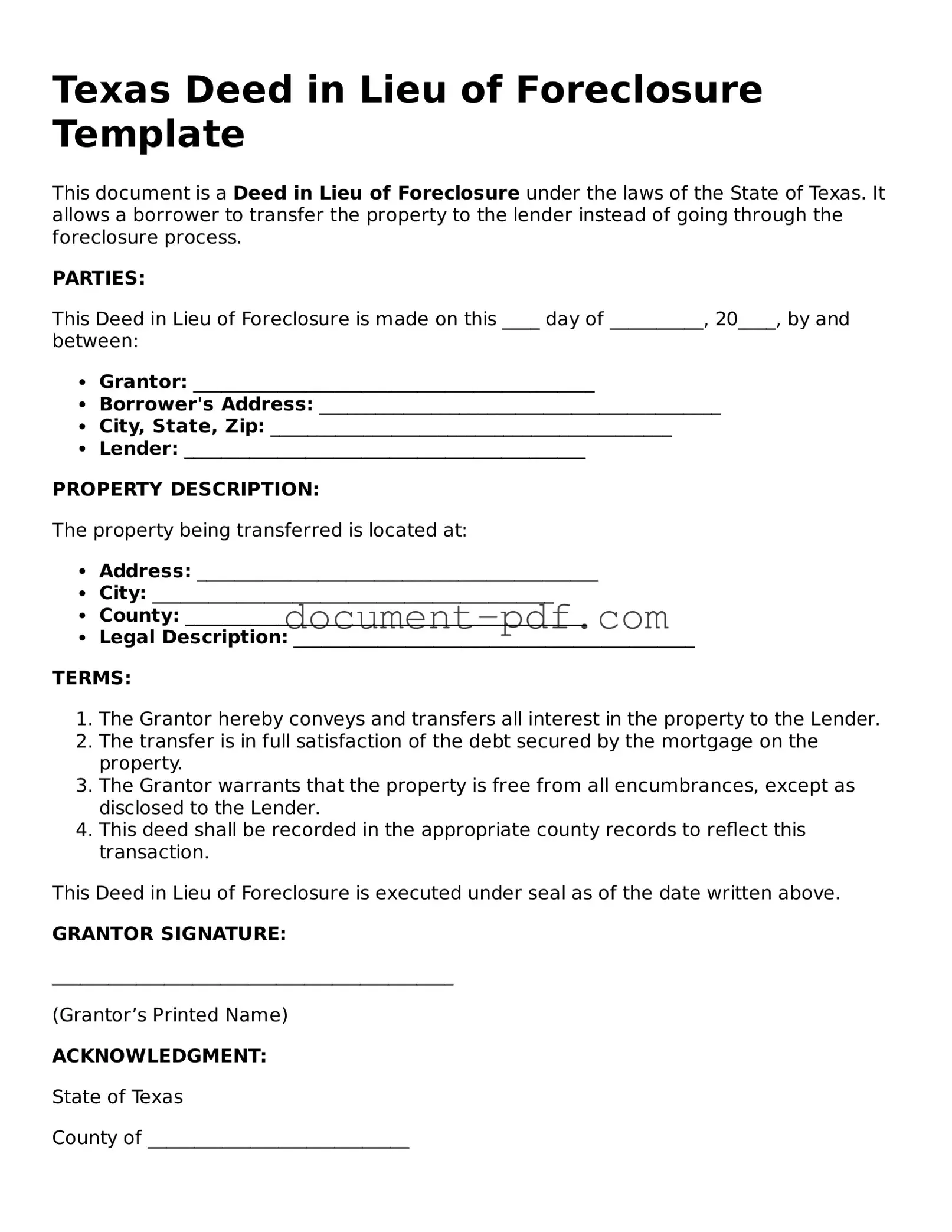The Texas Deed in Lieu of Foreclosure form shares similarities with a mortgage modification agreement. Both documents aim to provide solutions for homeowners facing financial difficulties. A mortgage modification agreement allows borrowers to adjust the terms of their existing mortgage, potentially lowering monthly payments or extending the loan term. This can help homeowners avoid foreclosure by making their payments more manageable, while a deed in lieu offers a more immediate resolution by transferring ownership of the property back to the lender.
Another document comparable to the Texas Deed in Lieu of Foreclosure is the short sale agreement. In a short sale, a homeowner sells their property for less than the amount owed on the mortgage, with the lender's approval. This option allows the homeowner to avoid foreclosure while still satisfying the lender to some extent. Like a deed in lieu, a short sale helps mitigate the financial impact on both the borrower and the lender, although the processes and implications differ significantly.
For those navigating the complexities of renting in New York, understanding the legal nuances of a New York Residential Lease Agreement can be vital. This document, which outlines critical elements such as rent amounts and lease durations, ensures both landlords and tenants are on the same page. To access a reliable template for this agreement, you can visit New York PDF Docs, which provides essential resources for a smooth rental process.
The promissory note is also related to the Deed in Lieu of Foreclosure. A promissory note is a legal document in which a borrower agrees to repay a loan under specific terms. In situations where a deed in lieu is executed, the promissory note may still exist, but the borrower is effectively relinquishing their obligation to repay the loan by handing over the property. This can simplify the process for both parties, as the lender may choose to forgive the remaining debt after the property transfer.
Similarly, the foreclosure notice acts as a precursor to the Deed in Lieu of Foreclosure. A foreclosure notice is typically issued when a borrower falls behind on mortgage payments, indicating the lender's intent to reclaim the property. While the notice signals a potential loss of the home, a deed in lieu can serve as an alternative to this process, allowing homeowners to proactively address their situation and avoid the more lengthy and damaging foreclosure proceedings.
The release of lien document also parallels the Deed in Lieu of Foreclosure. This document is used to formally remove a lender's claim on a property once the debt has been satisfied. In the case of a deed in lieu, once the property is transferred to the lender, a release of lien is often issued to confirm that the borrower no longer holds any obligations to the lender regarding that property. This helps clarify ownership and debt status for both parties.
A quitclaim deed shares some similarities with the Texas Deed in Lieu of Foreclosure. A quitclaim deed transfers ownership of property without guaranteeing that the title is clear or free of liens. While a deed in lieu is a more formal process involving the lender's acceptance, a quitclaim deed can be used to quickly transfer property rights, often among family members or in situations where the parties trust one another. However, the lack of guarantees in a quitclaim deed can lead to complications that are typically avoided in a deed in lieu arrangement.
The assumption of mortgage agreement is another document that relates to the Deed in Lieu of Foreclosure. In an assumption of mortgage, a buyer agrees to take over the seller's mortgage payments. This can be beneficial for sellers looking to exit their mortgage without facing foreclosure. Although it involves a transfer of responsibility rather than ownership, both documents aim to provide alternatives to foreclosure and can help borrowers navigate financial difficulties.
Additionally, a forbearance agreement can be compared to the Texas Deed in Lieu of Foreclosure. A forbearance agreement allows a borrower to temporarily pause or reduce mortgage payments during financial hardship. While this option can provide immediate relief, it does not resolve the underlying debt. In contrast, a deed in lieu offers a more definitive solution by transferring the property back to the lender, thus eliminating the borrower's debt obligation.
Lastly, the bankruptcy filing can be viewed as a related document. When individuals file for bankruptcy, they seek protection from creditors and may include their mortgage debt in the proceedings. While bankruptcy can provide a fresh start and potentially halt foreclosure, it often involves complex legal processes. A deed in lieu, on the other hand, provides a more straightforward approach for homeowners who wish to relinquish their property without going through bankruptcy court.
